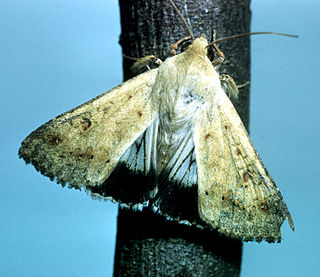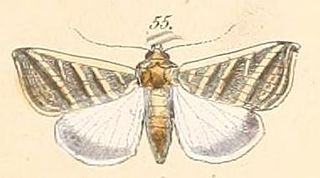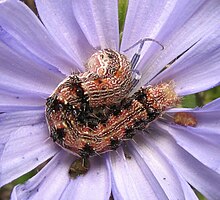
Nicotiana is a genus of herbaceous plants and shrubs in the family Solanaceae, that is indigenous to the Americas, Australia, south west Africa and the South Pacific. Various Nicotiana species, commonly referred to as tobacco plants, are cultivated as ornamental garden plants. N. tabacum is grown worldwide for production of tobacco leaf for cigarettes and other tobacco products.

The Noctuidae, commonly known as owlet moths, cutworms or armyworms, are the most controversial family in the superfamily Noctuoidea because many of the clades are constantly changing, along with the other families of the Noctuoidea. It was considered the largest family in Lepidoptera for a long time, but after regrouping Lymantriinae, Catocalinae and Calpinae within the family Erebidae, the latter holds this title now. Currently, Noctuidae is the second largest family in Noctuoidea, with about 1,089 genera and 11,772 species. However, this classification is still contingent, as more changes continue to appear between Noctuidae and Erebidae.

Helicoverpa zea, commonly known as the corn earworm, is a species in the family Noctuidae. The larva of the moth Helicoverpa zea is a major agricultural pest. Since it is polyphagous during the larval stage, the species has been given many different common names, including the cotton bollworm and the tomato fruitworm. It also consumes a wide variety of other crops.

Heliothis is a genus of moths in the family Noctuidae. It was first described by Ferdinand Ochsenheimer in 1816. Some of the species have larvae which are agricultural pests on crop species such as tobacco, cotton, soybean and pigeon pea. Some species originally in this genus have been moved to other genera, see Chloridea and Helicoverpa.

Helicoverpa punctigera, the native budworm or Australian bollworm, is a species of moth in the family Noctuidae. This species is native to Australia. H. punctigera are capable of long distance migration from their inland Australian habitat towards coastal regions and are an occasional migrant to New Zealand.

Heliothis punctifera or the lesser budworm, is an Australian moth of the family Noctuidae; one of the most migratory families of insects. It is considered a pest species to agricultural crops, however, due to its inland habitat, is found to be less damaging to agricultural areas than other species of the genus.

Chloridea virescens, commonly known as the tobacco budworm, is a moth of the family Noctuidae found throughout the eastern and southwestern United States along with parts of Central America and South America.
Curubasa was a genus of moths of the family Noctuidae, it is now considered a synonym of Heliothis.
Dysocnemis was a genus of moths of the family Noctuidae, it is now considered to be a synonym of Heliothis.
Lecerfia was a genus of moths of the family Noctuidae, it is now considered a synonym of Heliothis.
Libyphaenis is a monotypic moth genus of the family Noctuidae. Its only species, Libyphaenis virescens, is found in southern Nigeria. Both the genus and species were first described by George Hampson in 1918.

Masalia was a genus of moths of the family Noctuidae. It is now considered to be a subgenus of Heliothis.
Neocleptria was a genus of moths of the family Noctuidae, it is now considered a synonym of Heliothis.
Peltothis is a genus of moths of the family Noctuidae. It was proposed for Heliothis peltigera, but is not widely accepted.
Pradatta was a genus of moths of the family Noctuidae, it is now considered a synonym of Heliothis.
Rhodosea was a genus of moths of the family Noctuidae, it is now considered to be a synonym of Heliothis.
Heliothis philbyi is a species of moth of the family Noctuidae. It is found in the Middle East, including Saudi Arabia, Iran and Oman.

Chloridea subflexa is a moth of the family Noctuidae first described by Achille Guenée in 1852. It is found from most of the United States, throughout the Antilles, and south to Argentina.

Heliothinae is a small subfamily of moths in the family Noctuidae. There are about 400 species described worldwide. They are found predominantly in semiarid subtropical habitats.

Chloridea tergemina is a species of moth of the family Noctuidae. It is found in South America, including Brazil.











